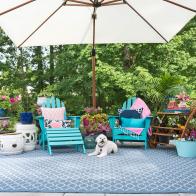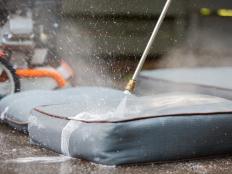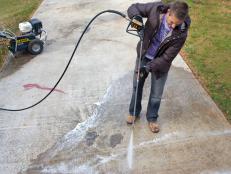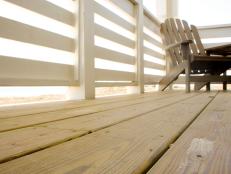How to Pressure Wash Almost Everything Around Your House
Get tips on how to power wash a variety of outdoor items including siding, decks, patios and kids' playsets. Plus, find information on buying a pressure washer, when to pressure wash and FAQs about how they work.
Related To:

Photo By: MaryAnnCarter
Photo By: MaryAnnCarter
Photo By: Flynnside Out Productions
Photo By: MaryAnnCarter
Photo By: Flynnside Out Productions
Photo By: Flynnside Out Productions
Photo By: MachineHeadz/©Getty Images
Photo By: Flynnside Out Productions
Photo By: Flynnside Out Productions
Photo By: Flynnside Out Productions
Photo By: bubutu
Photo By: MaryAnnCarter
Photo By: Flynnside Out Productions
Photo By: Flynnside Out Productions
Photo By: MaryAnnCarter
Photo By: MaryAnnCarter
Photo By: Flynnside Out Productions
Photo By: MaryAnnCarter
Photo By: MaryAnnCarter
You’d Be Surprised What You Can Clean Using a Pressure Washer
Sure, you can use a pressure washer to clean a deck, patio, swimming pool or driveway, but you can also clean kids’ toys and playsets, outdoor furniture, cushions, garbage cans, fences, cars, boats and more.
If you're not sure you want to invest in a pressure washer, rent one instead. This way you can learn how to use it and if you do decide to buy one, it'll help you determine what type you need. The key to successful pressure washing is starting out slow and working your way up to the appropriate settings.
Like many tools, a pressure washer can be dangerous if used incorrectly. Be sure to start with the lowest nozzle and work your way up to avoid damaging the surface you're cleaning. Wear goggles and closed-toe shoes and keep the kids and pets out of the way.
If you love a good before and after, then prepare to fall in love with pressure washing. It can be so satisfying!
When is the Best Time to Pressure Wash?
For most of us, the best time to pressure wash is spring and fall because of the mild temperatures. You can do it in the summer, but that depends on your location. In a hot and humid climate, drying times will take a lot longer. But, if you live in a northern area with cool summers and long days, summer may be the perfect time to pressure wash.
Winter is not a great time to pressure wash. Ideally, you want to pressure wash when the temperature is above 40 degrees, and the forecast is dry and sunny. Do not pressure wash when the temperature is or is forecasted to go below freezing. Surfaces can stay wet a long time; the water will likely have worked its way into cracks and crevices that won’t quickly dry, and a freeze-thaw cycle during drying time may damage surfaces like concrete and wood. Also, water left in the pressure washer’s hoses may do damage to the machine if it freezes.
Many people pressure wash twice a year: once in the spring to clean off winter dirt and grime, and again in the fall to remove algae and mold that grew over the summer. You may find it best to wait until late fall to pressure wash so you can remove fallen leaves that have left stains as well as sap or pollen that have built up on decks, roofs, concrete and siding.
The best time of day depends on the time of year and what surface you’re washing. The sun should be your deciding factor; pressure wash when the sun can speed up your drying times. In cooler weather like early spring and late fall, the warm afternoon sun may work best for you, while in the summer, early morning, before it gets too hot may be your optimum time.
Learn More: Pressure Wash Like a Boss
What do PSI and GPM Mean?
When you shop for a pressure washer, there are two important acronyms to know: PSI and GPM. Pound force per square inch (PSI) measures how powerful the water spray is. Gallons per minute (GPM) measures how much water goes through the spray wand. The higher the PSI and GPM, the more forceful and heavy the machine will be. A pressure washer with 2,000 PSI and 2 GPM is considered modest power and is good for light jobs such as cleaning decks, cars or swimming pools. If you need a machine for more arduous tasks such as cleaning a driveway, stone or brick, consider a medium-duty machine with a PSI of up to 3,200 and GPM of up to 3. Higher than that is considered maximum power, pro-grade. Most household jobs do not require a pro-grade, industrial PSI or GPM. It’s too much power and can strip surface paint or worse. Also, you may also see the term cleaning unit (CU) when shopping for a pressure washer. A cleaning unit is determined by multiplying the PSI by the GPM.
What are the Different Colored Nozzles?
Just about all pressure washers come with three to four nozzles, all different colors. The colors indicate the force of the spray. The most powerful nozzle will be the one with the smallest hole — limited flow equals increased velocity and power. On most machines, that will be the red nozzle. It is also called the 0-degree nozzle because the water does not fan out, it flows in a straight powerful stream. The next powerful nozzle shoots at a 15-degree angle; it is usually yellow. The green nozzle has a 25-degree angle followed by the most gentle, the white nozzle with a 40-degree angle. Most pressure washers will also come with a 65-degree angled nozzle which is used to spray soap onto your cleaning surface.
Different manufacturers mark their nozzles differently, so don't rely on the color alone. Always check the stamping on the nozzle. Just remember, the smaller the angle number, the more powerful it will be. It's always best to start with the least powerful spray (higher number) and work your way up. Don’t just blast away with the red nozzle or you may end up with a permanently damaged surface.
Should I Rent or Buy a Pressure Washer?
If you're going to use a pressure washer one or two times a year, then renting may be more cost-efficient. If you live in a warm and humid climate where mold, mildew and algae grow on exterior surfaces, buying a pressure washer is likely going to be the better choice. Also, owning allows you to avoid the time involved in picking it up and returning it to the rental center, especially a heavy, gas-powered unit.
Learn More: The Best Pressure Washers Under $500 for Every Job
Which is Better? An Electric or Gas Pressure Washer?
Deciding between an electric or gas pressure washer is fairly simple. If you need a lot of power, can handle moderately heavy equipment and are fine with loud noises, then a gas-powered model might be right for you. If you’re doing frequent light-duty cleaning and prefer a lightweight unit that’s quiet and easy to start, then a well-reviewed electric model may be the way to go. Keep in mind that the dirtier the surface, the more power you need. An electric model may be easier to maneuver, but it will take a lot longer to get the job done. No matter which one you choose, make sure the unit has a solid warranty on the pump and engine.
Learn More: The Best Pressure Washers Under $500 for Every Job
Wear Protection
While pressure washing may seem no different than cleaning with a regular hose, some key safety concerns need to be kept in mind. Because the water is at such high pressure, it poses physical harm at direct contact and it can also send dislodged materials hurling through the air at high speeds. Wear safety glasses, water-resistant clothing and closed-toe shoes. And if using a gas-powered model, you'll want to wear ear protection.
Another tip: Never point the spray nozzle toward someone even if the machine is turned off in case of an accidental discharge.
Cover Plants + Furnishings
A blast of water from a pressure washer can destroy plants and shrubbery. Use a tarp or drop cloth to cover nearby landscaping, patio furniture, outdoor accessories and anything else that could potentially be damaged.
One more thing: Be sure to keep water away from electrical outlets, and use extension cords approved for wet conditions.
What Shouldn't You Pressure Wash?
It’s easy to get carried away when you discover the cleaning power in that wand, but you should never pressure wash anything that is delicate and easily breakable.
Never use a pressure washer on these items:
- - Any living thing like plants, people and pets.
- - Thin glass.
- - Aging brick and mortar will just crumble.
- - Don't use the pressure washer on your electrical meter; if water seeps into the wrong places you could end up having to pay your utility company big bucks to replace it.
Use extreme caution or avoid pressure washing these surfaces:
- - Be careful around the air conditioning unit because you can bend or break the fins and vents.
- - Non-factory painted or stained surfaces; if they weren't sealed correctly the paint can be stripped off.
- - Surfaces painted pre-1978 may contain lead, so use the proper precaution to protect yourself from lead exposure.
- - The granules on old asphalt roof shingles can fly off even at a low setting; if that happens, use a garden hose instead.
- - Windows, a broken pane is a pain.
Use Solutions for Problem Areas
Most units have a reservoir and special nozzle (usually the black one) for spraying soap or cleaning solutions onto a surface. Depending on what you’re cleaning, there’s probably a special cleaning solution that can make the job a bit easier. Degreasers are great for driveways, and a multipurpose house wash will help remove grime from your home’s patio or siding. For an extra boost, scrub the suds in and leave them on for a few minutes before rinsing.
Clean: Siding
Power washing exterior siding can be tricky because some siding material can be easily gouged if sprayed with too much force. The nozzle you use for siding will depend on the type of siding and the PSI of your machine. No matter the surface, ease into it and stand a good distance away from the house, like 15 to 20 feet away. (The pressure will be lower the further you are from the targeted surface.) If you don’t see the siding moving or shaking, walk forward and continue spraying. Only increase the nozzle pressure if you’re sure it won’t damage the surface of your siding. Start in an inconspicuous area just in case gouging does occur. For softer materials like stucco and fiber cement, start with the lowest angle nozzle. With wood, aluminum and vinyl siding, try an angle in the middle, but again, stand back and ease into it. Solid materials like brick, stone and steel can take a higher spray like the 15-degree nozzle.
Start at the top of the house and work your down. If a ladder is necessary to power wash your siding, consider hiring a pro; using a pressure washer on a ladder can be dangerous.
Clean: Deck
Start with a low-powered 40-degree nozzle. The trick is to keep the spray moving. Don't rest in one spot for too long or it could permanently gash the surface. When the wood is completely dry, apply a wood preservative to help prevent water damage and discoloration.
Learn More: Deck Building: Materials and Construction Basics
Clean: Concrete
For heavy stains — like oil on a driveway — pretreat the surface with a degreaser. Then, using the soap tip on the pressure washer, spray the entire area with detergent and be sure to rinse before it dries. A 15- to 25-degree angle nozzle will provide enough power to rinse away dirt without damaging the surface. Spray the entire surface working left to right keeping the tip about 12 inches away from the surface. Spray in a consistent sweeping motion to prevent streaks.
Learn More: How to Repair and Reseal an Asphalt Driveway or Walkway
Clean: Wood Fence
For wood surfaces such as a fence, start with a 40-degree nozzle to avoid splintering. Start at the top and move vertically to prevent streaks. Overlap each pass for consistent cleaning and keep a distance of 12 to 16 inches. If the fence is heavily soiled, use a detergent before pressure washing.
Clean: Gutters
A pressure washer can speed up the process of gutter cleaning, but safety is key. If you’re on a ladder, make sure you’ve gotten comfortable using the unit and know the force of the spray before you begin. Also, be careful to avoid shooting the water stream directly under the shingles or onto windows. Start with a 40-degree angled nozzle to avoid denting the gutters.
Clean: Cars
Even if you don't go four-wheeling in the mud, a pressure washer can make cleaning a vehicle much faster and more enjoyable. Plus, it’s a quick way to remove stubborn mud, dirt and salt deposits. Just be sure to use the gentler 40-degree nozzle on the paint. For tires and wheels, you can amp up the intensity.
Clean: Outdoor Furniture
Most composite wood, mesh, plastic and wood patio furniture can be pressure washed. Place the furniture on a level surface away from any windows. Spot-clean tough stains with soap and brush or rag. Using a 40-degree nozzle, clean the furniture working top to bottom. For painted surfaces (not painted by the manufacturer), start in an inconspicuous spot in case the water pressure starts to remove the paint.
Clean: Cushions
Heavy-duty outdoor fabrics can be pressure washed too. Simply set them on a stable surface and wash them side to side, keeping a distance of at least 16 inches. Lay them in the sun to dry or pop them in the dryer.
Clean: Kids' Playset
Another great way to put that pressure washer to work is to use it on your kids' playset, wagons and outdoor toys. Go with a 40-degree nozzle to start then work up if necessary. Plastic and wood can be soft and damaged if you’re not careful. Pre-treat with a vinegar-based cleaning solution, then rinse from the top down.
Clean: Bikes
For bicycles start with a low-setting nozzle such as 40 degrees, especially around the tires and the seat. If the metal parts are still dirty, work your way up to a lower-degree nozzle.
Clean: Garbage Cans
If your trash cans are dirty on the outside and smelly on the inside, give them an all-over washing. Pour detergent and water inside the can and let it sit for a while to disinfect and help remove the smell. Then start with a 40-degree nozzle to avoid gouging the surface.









